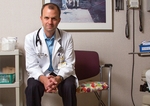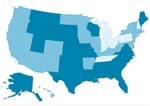business
How physician practices can stir up Pinterest
■ A practical look at information technology issues and usage
- WITH THIS STORY:
- » External links
Many doctors’ waiting rooms have a bulletin board where patients can find a copy of a local newspaper story in which one of their physicians was quoted, pictures of new employees or public service announcement posters reminding them to get their flu shots.
If you’re not already familiar with Pinterest, the social media site that had the distinction of being the fastest growing for the first quarter of 2012, it’s basically an electronic version of that bulletin board. While other social media sites allow pictures to be posted, Pinterest is driven by photos and images, with few words. Before you say, “Not another social media site to worry about,” think of this: What can make Pinterest desirable is that its audience, depending on who’s doing the estimate, is 60% to 97% female. That matters, because the Bureau of Labor Statistics notes that 80% of women are the primary health care decision-maker in their families.
For the moment, Pinterest is where Facebook and Twitter were a few years ago for many in health care — a curiosity that might be adapted for professional use if someone on staff happens to use it personally. But health care organizations that have begun using Pinterest say it’s an easy way to burnish their image. Because Pinterest is not a conversational site like Facebook or Twitter, it requires very little time, maybe only a few minutes per day or week, to keep up a presence.
Pinterest, which launched in September 2010, is where users find or share a combination of inspiration and eye candy through visual displays that are “pinned” on electronic boards. Pictures are either uploaded from somewhere else online or from a user’s computer. If the source is another website, there is usually a link back to that site. Users can comment on those pictures, but it’s more common to “re-pin” something that they like on their boards so their group of followers can see it. In mid-August, Pinterest lifted a restriction that people could join only by invitation from an existing user, so anyone may now start a page.
No big investment needed
There is widespread agreement among the early health care entrants that the investment of time and money spent to develop a presence on Pinterest is actually close to nothing. Many feel they have nothing to lose and have adopted a “why not” attitude. Others recommend that practices do not jump right in with no plan for making their Pinterest efforts a success.
Holly Hosler, marketing coordinator for LifeBridge Health, a hospital system in Baltimore, said that when several people in the hospital’s marketing department found they were spending a lot of time on Pinterest, they decided to start some on-the-job experimentation. They launched a board in March.
Their activity has mostly consisted of re-pinning content from other places. The content that has done well — and in Pinterest-speak “well” means that several people re-pinned the content — has been educational information about breastfeeding, especially posts that feature a picture of a cute baby to lure users. Hosler said she hopes to add more original content if interest in the site continues.
Unlike Facebook, where there’s an expectation to post something several times a day, Hosler said she posts on Pinterest only a few times a week.
“We’re still learning,” she said. “It’s a really nascent account & and we’re just kind of playing around with it to see where it takes us.”
A lot of the health care-related activity on Pinterest has come from large corporations such as pharmaceutical companies, said Jessica Seilheimer, senior vice president of digital strategy and planning for Euro RSCG Life Metamax, a health care marketing firm.
Because of the site’s focus on lifestyle issues, much of the content coming from the health care industry has been on topics such as fitness and eating well. Because of this narrow focus, Pinterest isn’t to a point where people are using it to seek out physician practices, Seilheimer said. But others say potential patients could stumble upon a practice’s website because of something that caught their eye on Pinterest.
The idea is visual stimulation. While cute babies are eye-catching, a picture of a doctor giving someone medicine wouldn’t have the same draw. Because Pinterest was created as a place where users can share their visual examples of “an ideal lifestyle,” health care organizations shouldn’t stray too far from that, Hosler said.
Hashtags a plus
There are some secrets to gaining a wider audience, Seilheimer said.
Using hashtags, like on Twitter, allows users to find content based on a topic. For example, the posting of a picture of a healthy dish that has a link to the recipe might include the hashtag #healthyrecipe. Because Pinterest users tend to follow people for their content as opposed to their geographic location, using your region as a hashtag can help local users find you.
The Seasons Wellness Clinic, a Ruston, La., gynecology practice that also offers wellness and medical spa services, said hashtags have been key to attracting patients from the area to its Pinterest board. Elizabeth Haynes Drewett, managing partner of Spring Media USA, the marketing firm that spun off from Seasons’ in-house marketing team, said 75% of the followers of the clinic’s Pinterest board are local. Many of the items pinned on the board have a hashtag of #louisiana.
Seilheimer said organizations need to link the Pinterest content back to their own sites. Pinterest has become one of the most powerful referrals to electronic commerce sites, Seilheimer said. Although most physicians aren’t selling anything on their websites, a referral from Pinterest could mean a new patient.
UW Health at the University of Wisconsin is viewing Pinterest as a way of re-purposing content found on its other websites, blogs and social media sites, said Jennifer Walker, UW Health social media and information architect.
She said the Pinterest activity hasn’t shown much of a return on investment, but it has become a job responsibility she tends to “when I have time,” so the time investment hasn’t been that great. Because the expectations are different from those associated with Facebook and Twitter, she said she feels OK about not posting daily.
But it wouldn’t be her first recommendation for a busy physician practice, she said. Facebook would be her first choice because of its ability to reach a more targeted audience.
Drewett said it might not make sense for every physician practice to get on Pinterest. But if a practice has a website with a lot of visual features that can be re-purposed for Pinterest, and someone in the practice enjoys social media and is interested in doing it, it could be a good way to increase the website’s ability to be found. The more sites linking back to the main website, the more likely it is to show up high in a Google search.












